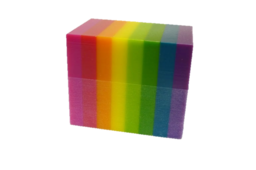Getting Started: PolyJet 3D Printing Materials
Your 3D prints are only as strong, as flexible, as soft or as smooth as you make them. When it comes to PolyJet 3D printing and prototyping, it's crucial to make sure you are working with the right materials to get the look, feel and function you want.
Below, we explain the various PolyJet 3D printing material options and when you should use certain materials to get the results you want. Whether you're looking for the strongest 3D printing material or the most flexible, there's a material for every scenario.
3D Printing with Rigid Opaque and Transparent PolyJet Materials
 This tutorial gives you tips for how to use various rigid materials on Stratasys PolyJet printers. This includes the entire Vero family, as well as the VeroClear, VeroFlex, and VeroVivids.
This tutorial gives you tips for how to use various rigid materials on Stratasys PolyJet printers. This includes the entire Vero family, as well as the VeroClear, VeroFlex, and VeroVivids.
- Vero: this photopolymer offer strength, stiffness and versatility in blue, white, black, gray, cyan, magenta and yellow. It's ideal for 3D printing accurate parts for testing and surgical planning. Vero materials are also offered in clear, flex.
- VeroClear (RGD810) is a transparent PolyJet photopolymer for clear acrylic simulation. It offers strength and stiffness and can even blend with other materials. It's ideal for form-and-fit testing of see-through parts.
- VeroFlex: this Vero material is for the eye-wear manufacturing. Due to its specially blended materials and combination of flexibility and stiffness, VeroFlex is perfect for imitating eye-wear look and feel.
- VeroVivid: this material unlocks the best color capabilities, including Pantone™. It's great for advanced applications like printing multi-color, multi-material, multi-texture prototypes.
3D Printing with Flexible PolyJet Materials
Working with materials that can simulate flexibility is key. PolyJet 3D printing offers an array of flexible materials, including the Tango and Agilus30 families. This tutorial will help you understand how to work with both.
- Agilus30: a rubber-like PolyJet photopolymer, great for rapid prototyping. This material is stronger than Tango, and a better tear-resistant option for prototypes that need to hold up to repeatable flexing and bending.
- Tango: also offers rubber-like qualities. It's ideal for producing soft, flexible prototypes that require shock absorption, vibration dampening or a non-slip surface.
3D Printing with PolyJet High Performance Materials
This tutorial will help you prepare for working with Digital ABS Plus, Rigur, and High-Temperature RGD525. These are high performance materials for Stratasys printers.
- Digital ABS Plus: a high-performance material that is good for creating realistic, precise parts and tools that are tough and heat resistant. It's great for prototypes requiring improved mechanical properties and thermal performance.
- Rigur RGD450: a white model material that simulates polypropylene in appearance and functionality. It's ideal for when you need durability, dimensional stability, and surface quality.
- High-Temperature RGD525: a material that is suitable for static applications that require high temperature resistance. It offers exceptional dimensional stability and great thermal resistance.

Now that you understand all the 3D printing materials PolyJet has to offer, learn about optimizing the model in GrabCAD Print to get the best print finish.
What 3D printing material are you working with? Stratasys Advanced Materials support a wide range of 3D Printing Solutions for all use cases. Find the one that's right for your needs!
Do you already know which PolyJet 3D printing materials you want? Shop Stratasys Materials now!










